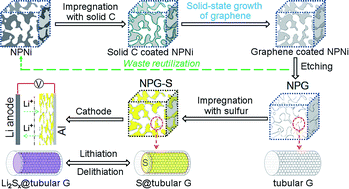Low-temperature solid-state growth of three-dimensional bicontinuous nanoporous graphene with tunable porosity for lithium–sulfur batteries†
Abstract
In this work we developed a solid-state-growth approach for the synthesis of 3D interconnected bicontinuous nanoporous graphene (NPG) with the aid of nanoporous Ni templates at low temperatures (below 800 °C). The as-synthesized nanoporous graphene comprises both interconnected tubular pores and non-tubular pores. The layer thickness of NPG can be controlled from monolayer to multilayer. The porosity and tubular pore sizes of bicontinuous NPG could be adjusted from tens of nanometres to hundreds of nanometers by varying the ligament size of nanoporous Ni templates. Three types of NPG with average tubular pore sizes of 1000 nm, 160 nm, 50 nm were synthesized. NPG can also be made in the forms of powders up to macroscopic foams depending on the shape and size of the Ni templates. The specific surface area can reach 555 m2 g−1. By encapsulation of sulfur in the tubular pores, the NPG–sulfur composites exhibited superb electrochemical performances such as enhanced capacities and cycling performances. The capacitive and cycling performances presented great improvements with decreasing the tubular pore size from 1000 to 50 nm and increasing the pore volume.



 Please wait while we load your content...
Please wait while we load your content...